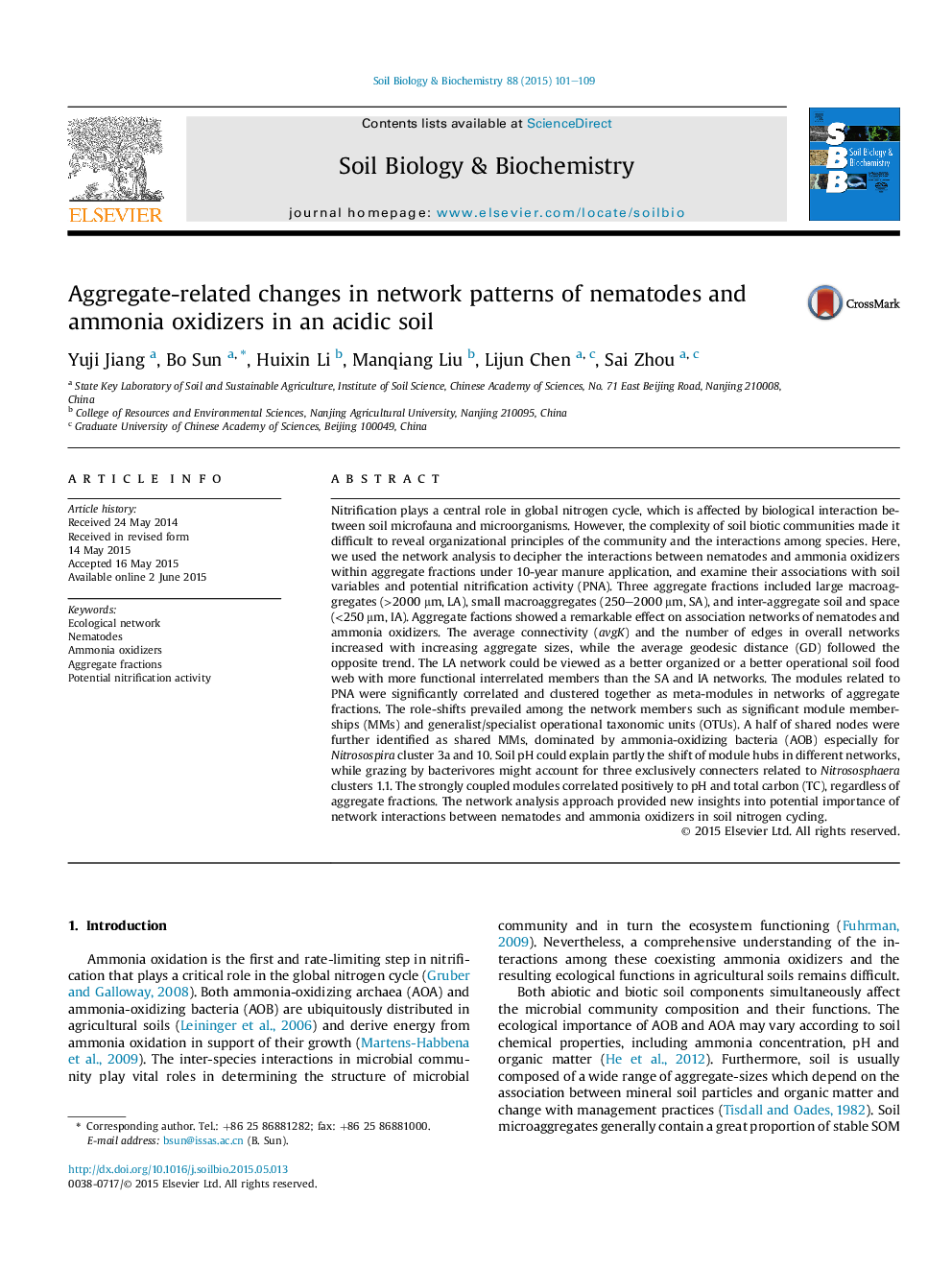| کد مقاله | کد نشریه | سال انتشار | مقاله انگلیسی | نسخه تمام متن |
|---|---|---|---|---|
| 8363937 | 1542596 | 2015 | 9 صفحه PDF | دانلود رایگان |
عنوان انگلیسی مقاله ISI
Aggregate-related changes in network patterns of nematodes and ammonia oxidizers in an acidic soil
ترجمه فارسی عنوان
تغییرات وابسته به جمع در الگوهای شبکه های نماتد و اکسید کننده آمونیاک در خاک اسیدی
دانلود مقاله + سفارش ترجمه
دانلود مقاله ISI انگلیسی
رایگان برای ایرانیان
کلمات کلیدی
شبکه زیست محیطی، نماتدها، اکسید کننده آمونیاک، فراکسیون جامد، فعالیت نیتروژن بالقوه،
موضوعات مرتبط
علوم زیستی و بیوفناوری
علوم کشاورزی و بیولوژیک
دانش خاک شناسی
چکیده انگلیسی
Nitrification plays a central role in global nitrogen cycle, which is affected by biological interaction between soil microfauna and microorganisms. However, the complexity of soil biotic communities made it difficult to reveal organizational principles of the community and the interactions among species. Here, we used the network analysis to decipher the interactions between nematodes and ammonia oxidizers within aggregate fractions under 10-year manure application, and examine their associations with soil variables and potential nitrification activity (PNA). Three aggregate fractions included large macroaggregates (>2000 μm, LA), small macroaggregates (250-2000 μm, SA), and inter-aggregate soil and space (<250 μm, IA). Aggregate factions showed a remarkable effect on association networks of nematodes and ammonia oxidizers. The average connectivity (avgK) and the number of edges in overall networks increased with increasing aggregate sizes, while the average geodesic distance (GD) followed the opposite trend. The LA network could be viewed as a better organized or a better operational soil food web with more functional interrelated members than the SA and IA networks. The modules related to PNA were significantly correlated and clustered together as meta-modules in networks of aggregate fractions. The role-shifts prevailed among the network members such as significant module memberships (MMs) and generalist/specialist operational taxonomic units (OTUs). A half of shared nodes were further identified as shared MMs, dominated by ammonia-oxidizing bacteria (AOB) especially for Nitrosospira cluster 3a and 10. Soil pH could explain partly the shift of module hubs in different networks, while grazing by bacterivores might account for three exclusively connecters related to Nitrososphaera clusters 1.1. The strongly coupled modules correlated positively to pH and total carbon (TC), regardless of aggregate fractions. The network analysis approach provided new insights into potential importance of network interactions between nematodes and ammonia oxidizers in soil nitrogen cycling.
ناشر
Database: Elsevier - ScienceDirect (ساینس دایرکت)
Journal: Soil Biology and Biochemistry - Volume 88, September 2015, Pages 101-109
Journal: Soil Biology and Biochemistry - Volume 88, September 2015, Pages 101-109
نویسندگان
Yuji Jiang, Bo Sun, Huixin Li, Manqiang Liu, Lijun Chen, Sai Zhou,
